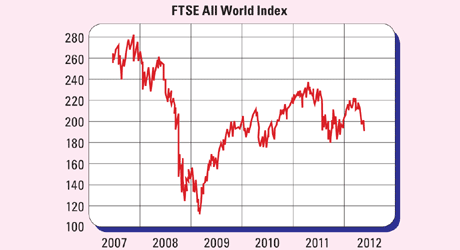
Last week was “a real game-changer” for markets, says Mark Schofield of Citigroup. “There is no good news anywhere.” The latest data have shown that growth in emerging markets and America is beginning to fade along with Europe’s. With nowhere left to hide, investors turned and fled. Global equities, as measured by the FTSE All-World Index, are now 14% down from this spring’s cyclical high.
The Euro Stoxx 50, a gauge of the eurozone’s 50 biggest stocks, lost 16% in the second quarter. Oil has fallen 20% in eight weeks. Investors have raced into government bonds, driving prices up and yields to record lows. German two-year yields went negative: investors were effectively paying to lend the German government money.
A perfect storm
Up until now, solid growth in emerging markets, notably China, and America has to an extent offset bad news in Europe. But now a synchronised global downturn looks imminent – a “perfect storm” for markets, says Paul Joseph Garcia.
In Europe, the news just keeps getting worse. Spain looks increasingly likely to need a bail-out and a gauge of eurozone manufacturing sector showed that activity has decreased for ten months in a row, hitting a three-year low in May. Germany’s equivalent index is also at a three-year low. The same goes for Britain, where new orders are shrinking at their fastest rate since the depths of the financial crisis in early 2009.
As for emerging markets, Brazil barely grew in the first quarter; India’s annual growth of 5.3% was its lowest in eight years; and China’s manufacturing sector continues to shrink. In America, a poor payrolls report, with a mere 69,000 jobs added in May, and a downward revision in GDP for the first quarter, confirmed fears that the American recovery is once again losing steam.
The fear and uncertainty among consumers and companies caused by the prospect of a euro meltdown is a “strengthening undertow in global economic waters”, says the Financial Times. It reinforces China’s self-induced slowdown as the eurozone takes a fifth of Chinese goods exports. China has further dented emerging-market growth, which, along with European uncertainty, now seems to be affecting America.
A poor outlook for earnings
Investors can’t count on things improving anytime soon. Europe’s turmoil endures and fears of a Chinese hard landing have grown. “The policy that [secures] 8% growth with no… busts has yet to be invented.”
In America, draconian automatic spending cuts and tax hikes will kick in at the end of the year due to last summer’s deal in Congress to raise the US debt ceiling. An “awesome fiscal squeeze” of around 4% of GDP looms unless lawmakers get their act together in time and renegotiate the package, which is unlikely in this “politically charged climate”, says Alan Abelson in Barron’s.
Another sugar rush?
Markets are “a busted flush” if investors are forced to rely on economic fundamentals, says Fxpro.com. However, as in 2010 and 2011 when the global economy faltered, central banks look increasingly likely to launch more quantitative easing (QE, money printing), which provides a sugar rush for risky assets.
These doses of liquidity haven’t solved the underlying debt problem, notes ES Browning in The Wall Street Journal. But they bolster markets by temporarily papering over cracks in the system, such as holes in bank balance sheets, while the injected money also find its way into risky asset markets. So if things get worse, markets may soon receive a new fix of QE.
But that, as Buttonwood says in The Economist, merely puts off the day when they can get by without a drug prescribed by central banks – surely a precondition for a sustainable, long-term bull market.